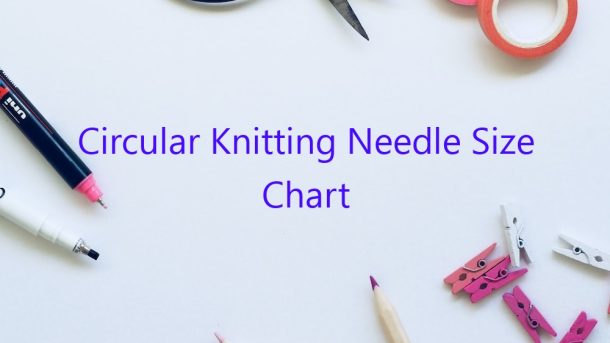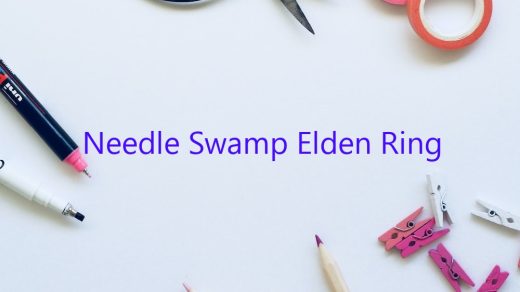Circular knitting needles are one of the most popular tools for knitters. They are available in a variety of sizes, from very small to very large. A knitter’s choice of circular needle size will depend on the weight and thickness of the yarn they are using, as well as the size of the project they are working on.
Here is a circular knitting needle size chart to help you choose the right size for your project:
US 0 (2mm)
US 1 (2.25mm)
US 1.5 (2.5mm)
US 2 (2.75mm)
US 2.5 (3mm)
US 3 (3.25mm)
US 4 (3.5mm)
US 5 (3.75mm)
US 6 (4mm)
US 7 (4.5mm)
US 8 (5mm)
US 9 (5.5mm)
US 10 (6mm)
US 10.5 (6.5mm)
US 11 (7mm)
US 13 (8mm)
US 15 (9mm)
US 17 (10mm)
US 19 (11mm)
US 35 (14mm)
US 50 (19mm)
Contents [hide]
How do you know what size circular knitting needles to use?
Knowing what size circular knitting needles to use can be tricky. The size of the needles you need depends on the weight of the yarn you are using and the size of the project you are making.
When you are choosing needles, you need to consider the thickness of the yarn. If you are using a thick yarn, you will need a larger needle size than if you are using a thin yarn. The size of the project you are making also matters. If you are making a small project, you will need smaller needles than if you are making a large project.
In general, you should use the smallest needles possible to make the project you are working on. This will help to make your project look neater and it will be less likely to stretch out.
If you are not sure what size needles to use, it is best to consult the yarn manufacturer’s recommended needle size. They will usually list the recommended needle size on the yarn label.
How many stitches fit on a 16 inch circular needle?
A 16 inch circular needle can accommodate a certain number of stitches, depending on the type of yarn and knitting technique being used. For example, a lace stitch pattern may only use a few stitches, while a bulky knit stitch pattern may use many more stitches.
What length circular needles should I buy?
When it comes to knitting, there are a few different things to consider when it comes to the tools of the trade. One of the most important decisions to make is what size needles to use, and that decision depends on the weight of the yarn you’re using.
Circular needles come in a variety of lengths, and the length you choose depends on the size of project you’re working on and the amount of ease you need. Here’s a general guide to help you choose the right length circular needles:
For projects up to 14″ in circumference, use a 16″ needle
For projects up to 24″ in circumference, use a 24″ needle
For projects up to 34″ in circumference, use a 32″ needle
For projects up to 44″ in circumference, use a 40″ needle
For projects up to 54″ in circumference, use a 48″ needle
For projects up to 64″ in circumference, use a 56″ needle
For projects up to 74″ in circumference, use a 64″ needle
For projects up to 84″ in circumference, use a 72″ needle
For projects up to 94″ in circumference, use a 80″ needle
What size circular knitting needles do I need for a hat?
What size circular knitting needles do I need for a hat?
This is a question that a lot of knitters have, and the answer can vary depending on the hat pattern you are using. However, in general, you will need needles that are at least 16 inches in length for a hat. If you are using a circular needle, the size you need will depend on the weight of the yarn you are using. For instance, if you are using a worsted weight yarn, you will need a needle that is size 8 or 9. If you are using a bulky weight yarn, you will need a needle that is size 11 or 12.
Does it matter how long your circular knitting needles are?
It is a common question that comes up for knitters – does it matter how long your circular knitting needles are? The answer is, it depends.
Circular knitting needles come in a range of different lengths, from 9 inches to 36 inches. The length you choose largely depends on the project you are working on. Larger projects, such as blankets or sweaters, will require longer needles. Smaller projects, such as socks or hats, can be worked on shorter needles.
There are a few things to keep in mind when choosing the length of your needles. First, make sure the needles are long enough to accommodate the number of stitches you are working with. If the stitches are too crowded on the needles, they can become difficult to work with. Secondly, the length of the needles can affect the way the fabric of your project looks and feels. Longer needles can create a looser fabric, while shorter needles create a more dense fabric.
Ultimately, it is up to the knitter to decide what length of needles works best for them and their project. experimentation is often the best way to find what works best.
What if circular needles are too long?
What if circular needles are too long?
Circular needles can be a great option for knitting in the round, but what if they’re too long for your project? There are a few things you can do to make them work.
If your circular needles are too long for your project, you can either shorten them or use two shorter needles instead. To shorten them, you can cut the cable and then rejoin it using a cable needle. If you’re using two shorter needles instead, you can use the magic loop method or the two-circular-needles method.
If you’re using the magic loop method, you can use a shorter circular needle to cast on and then use the longer needle to knit the project. When you’re done, switch needles and use the shorter needle to bind off.
If you’re using the two-circular-needles method, you can use two shorter needles to cast on and then use the longer needles to knit the project. When you’re done, switch needles and use the shorter needles to bind off.
Can circular needles be too long?
Circular needles can be too long for a few reasons. If the needles are too long, they can be difficult to control and may cause the knitter to lose their place in the knitting pattern. Additionally, if the needles are too long, they may be difficult to store.




